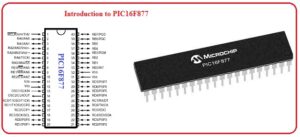 Hi fellows I hope you all are having fun in your daily life. In today’s post, we will have a detailed look at Introduction to PIC16F877. This is a basic type of microcontroller which is most commonly used. This module provides different types of features such as less expensive, reliable, easy to access, and better quality over other modules.
Hi fellows I hope you all are having fun in your daily life. In today’s post, we will have a detailed look at Introduction to PIC16F877. This is a basic type of microcontroller which is most commonly used. This module provides different types of features such as less expensive, reliable, easy to access, and better quality over other modules.
It is the best option for such an application that uses different types of machines like motors, measuring instruments, and different engineering projects. This controller all important features which usually exist in other controllers. In today’s post, we will have a detailed look at its working, operation, pinouts, and some other parameters. So let’s get started with the introduction to Introduction to PIC16F877.
Introduction to PIC16F877
- The PIC16F877 controller belongs to the PIC family of the controller. it is an eight-bit controller which was created by the Microchip.
- There are 3 different types of packaging structures in which it usually comes first one os PDIP (Plastic Dual In-line Package), the second one is PLCC (Plastic Leaded Chip Carrier), and the third one is Quad Flat No-leads package.
- In ist packaging arrangements there are forty pinouts and in QFN and PLCC, there are forty-four pinouts.
- There is EEPROM (electrically erasable programmable read-only memory) which has storage space of two fifty-six bytes, with that there is random access memory with space of three sixty bytes is created on this board.
- At this board, there is a timer, analog to digital converter, and some other important elements are assembled.
Features of PIC16F877
- These are some important features of this board which is mentioned here.
- This board comprises of the central processing unit which is based on RISC architecture.
- Its input clock has two megahertz frequency.
- There are normally forty pinouts is created at this board.
- Out of forty, there are thirty-three pins are used as input and outputs pins.
- Six pins are used as analog inputs pins.
- There is a flash memory of fourteen-kilo byte is created at this board.
- This board is incorporated with static ram having space of three sixty-eight bytes.
- There is EEPROM of having space of two fifty-six is created on this board.
- like other controllers, there is 3 timers that are assembled on this board which are timer, 1, 2, and 3.
- The voltage range for which it operates is four to 5.5 volts.
- The frequency of the oscillator to the twenty megahertz.
- The creator of this controller is Microchip.
- There are five ports are created on this board which are A, B, C, D and E.
- Two plus width modulation exist at this board.
- Analog to digital converter of ten bits with eight-channel is used at this board.
- There is a watchdog timer for observing the operation of different parts is exist at this board.
- The commonly used protocol for communication is UART, SPI, I2C, and ICSP.
Pinout of PIC16F877
- The pinouts of this board are described here with the details.
MCLR’VPP
- This pinout is used as master clear pinout.
RA0AN0
- This pin is used as digital input and output pinout.
RA1AN1
- This pin functions as digital input and output pinout.
RA2AN2VREF-
- This pinout is operating as digital input and output pins and also as reference pinout.
RA4T0CKI
- This pin is digital input and output pins and operates as the exterior clock input.
RA5AN4SS’
- This pinout is operated as digital input and output pin and used for the selection of SPI protocol.
RE0AN5RD
- That is also digital input and output pinout and operates input for parallel slaves device.
(AN0 TO AN7)
- These pins are used for the connection of analog inputs with the board.
TX and RX
- These pins are used as transmitters and receivers.
SCK
- Through this pinout, a serial clock input signal is given to the board.
SCL
- At this pin, SPI and I2C protocol are provided.
DT
- At this pin, synchronous data are provided.,
CK
- This pin is used as a connection of synchronous clock input.
SDO
- Through this pin output of the serial peripheral interface is taken out.
SD1
- The data input of spi is given at this pin.
So friends that is a detailed post about PIC16F877 I tried my level best to make this post simple for you. If you have any further query ask in comments. thanks for reading, Have a good day,






